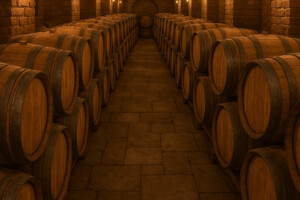
Every year, one bottle out of four of Brunello di Montalcino and one out of three of Chianti Classico fly to the United States, the reference market for all Italian wine exports that, in the first 11 months of 2021, invoiced more than 1.6 billion euros. This is an important result, especially because it arrived after two years of the pandemic that, in fact, marked a furrow capable of distancing the two sides of the Atlantic more than the Ocean was capable of. Now, however, the time has come to reduce the distance, to start traveling again, to tie up the threads of an interrupted discourse that has only been kept alive thanks to technology, which has made it possible to taste and meet at a distance. Nothing like the pleasure of clinking glasses, meeting eyes and sitting down at the same table: symbols of a restart that began some time ago, but which is only now, two years after the first cases of Covid-19 were recorded in Italy, getting underway. And it is no coincidence that the two standard bearers of Tuscan wine, one of the most important denominations in Italian wine-growing, have chosen New York to tell their stories to US importers, professionals and wine lovers, rediscovering themselves as pioneers in a market that, in effect, has never stopped.
Brunello di Montalcino, with 50 producers, will be on Fifth Avenue tomorrow, at the Midtown Loft & Terrace, with the US edition of “Benvenuto Brunello” curated by the Consortium that will raise the curtain on the 2017 vintage, the 2016 Riserva and the Rosso di Montalcino 2020, presented as a preview in November 2021, in Montalcino, at “Benvenuto Brunello” no. 30. Chianti Classico, on the other hand, has chosen the setting of the Altman Building to present, on February 28, Chianti Classico Annata (2018-2019), Riserva (2018-2017-2016) and Gran Selezione (2018-2017-2016), in a grand tasting that will revolve around the Additional Geographical Units (AGUs) of Chianti Classico, which, through the villages and hamlets, tell on the label the enormous variety of the Black Rooster territory, which in the U.S., for over 15 years, has its first market ever. So much so that, despite the pandemic and restrictions, even Gran Selezione has recorded significant results: +30% in 2021 over 2020, and the prospect of further growth for premium and super premium brands in 2022. Chianti Classico, with 52.5% of the vineyard area cultivated according to the dictates of organic farming, also intercepts another important trend that concerns American consumers, increasingly attentive to health and sustainability.
“This appointment is not only important to consolidate our presence in our main market in the world, with an export quota that exceeds 30% of the total, but also to give a signal of reopening to the world by the whole of Italian wine, which marks a key moment in a perspective of growth that, we are convinced, is destined to continue”, comments Fabrizio Bindocci, President of the Consorzio del Brunello, to WineNews. Which, “like the whole territory of Montalcino, has come through the last two very difficult years almost unscathed. Now, the world is ready to start again, to resume doing what it has always done until the beginning of this pandemic. We, producers, are going back to traveling and promoting our wines, wine lovers are going back to visit the great territories of Italian wine, including, at last, from the United States: those arriving from overseas will no longer need the buffer, an important signal in terms of tourism, which wineries, accommodation facilities and local businesses have been waiting for. In 2021 - concludes the President of the Consorzio del Brunello - Tuscan red wines in the States recorded a 26% jump in sales in value terms, with Brunello di Montalcino, together with the main regional denominations, the standard-bearer of Italian style overseas, as is also testified by the survey commissioned to Wine Intelligence, which sees Tuscany at the top of the foreign wine territories best known to American consumers”.
“I am very happy to be back in New York with our wineries and to be able to explain, through the project of the Chianti Classico Additional Geographical Units (UGA), the close link that exists between the Black Rooster wines and the place where they are produced”, comments Giovanni Manetti, president of the Consorzio Chianti Classico. “As I have always said, wine reflects the territory like a negative photographic image, and that is why it is so important both to preserve its environmental and landscape context and to be able to tell the consumer about it, in its various facets, even through the label”.
One of the objectives of the Uga (Additional Geographical Units) project is to strengthen communication of the wine-territory combination, increase quality in terms of identity and territoriality, allow consumers to know where the grapes come from and, last but not least, stimulate demand through an increasingly differentiated offer.
The introduction of the name of the village on the label will serve to intercept and satisfy the interest of consumers who, in ever-increasing numbers, especially in “mature” markets like the United States, wish to deepen their knowledge of the relationship between Black Rooster wines and their territory of origin. The wineries featured at the Altman Building will be divided by Additional Geographic Units (AGUs), and a “Chianti Classico AGU Winebar” will be set up in the location, where Jeff Porter, honorary ambassador of Chianti Classico, will guide guests through the various nuances of the Black Rooster. Also on the calendar are two seminars, one for the press and one for the trade, held by Alessandro Masnaghetti, a journalist and “mapman” who is working with the Chianti Classico Consortium on a 360-degree aerial mapping of the territory.
Copyright © 2000/2025
Contatti: info@winenews.it
Seguici anche su Twitter: @WineNewsIt
Seguici anche su Facebook: @winenewsit
Questo articolo è tratto dall'archivio di WineNews - Tutti i diritti riservati - Copyright © 2000/2025